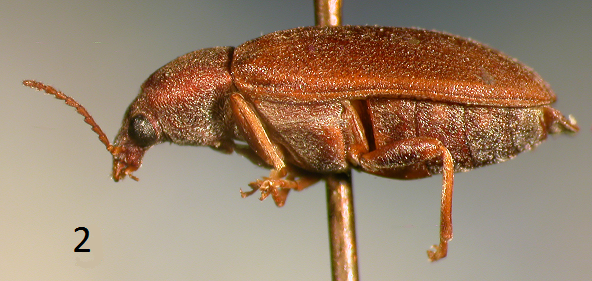Most people do not get excited about little brown beetles — especially those that don’t bite, cause disease or have economic value.

A new beetle species, Mycterus youngi, from Wisconsin. Photo: Darren Pollock
But a researcher that has dedicated his life to finding “orphan beetles” has discovered a previously unidentified beetle species endemic to two Wisconsin counties.
The findings are in the March issue of The Coleopterists Bulletin.
Darren Pollock, a professor at Eastern New Mexico University’s department of biology, examined dead beetles (three male and six female) that were housed at the University of Wisconsin Insect Research Collection and the Carnegie Museum of Natural History. As an expert on little brown beetles, or LBB’s as he calls them, he saw something right away.
“I have seen literally thousand of specimens of this genus (Mycteridae) and when I saw them for the first time, I knew they were unique,” Pollock said.
The beetles from Wisconsin are similar to a Florida species that Pollock indentified in 1993, but have different color schemes and the male genitals look different.
The research collection specimens came from two Wisconsin counties, Iowa and Wood. The two from the Carnegie Museum were labeled “L.S.,” which Pollock assumes is Lake Superior.
It is not known whether these beetles are still in Wisconsin. The earliest specimens were from the 1940s but one was from 2010.
And most people probably do not care.

Another view of the little brown critter. Photo: Darren Pollock
But Pollock does — he speaks about little brown beetles with a hint of sentimentality; fearing that these kinds of species often “fall through the cracks.”
“If someone determines that a beetle chews leaves or kills trees, someone will get big money from a funder and nail down the species — but not Mycteridae,” Pollock said. “They’re pretty much completely ignored.”
But not totally ignored. Pollock guessed that there are about 10 people in the world who research these “little beetles.” And one of those 10 sent him the specimens.
“He’s the expert on that family,” said Dan Young, director of the Wisconsin Insect Research Collection. “And he wanted some unidentified beetles.”
The two have known each other for about 30 years, Young said. They both share a love for the little brown beetles.
Having grown up a fly angler in Michigan, Young became interested in insects at a young age, but people already knew so much about aquatic insects, he said. So he became a beetle guy.
“The group is just so imposingly large and biologically diverse,” Young said. “You can discover things that people have never known before.”
And that’s what Pollock did with the samples from his long-time colleague. And he returned the favor like a good buddy should — by naming the new species, Mycterus youngi, after Young.
“I was honored … it’s a feeling of slight immortality,” Young said with a chuckle.
With the new species identified and documented, not much will change, Pollock admitted. Wisconsin officials will probably add the beetle to their species’ list and look for it in the field. A world publication called Zoological Record, which documents all new species, will add it, Pollock said.
But for the LBB researcher, it’s not about the glory.
“It’s not that I feel sorry for them,” Pollock said. “But they’ve been languishing for literally thousands of years.”
Pollock and Young’s seemingly bland passion stems from the root of all science — discovery.
“I just want to keep adding to the list of things we didn’t know,” Pollock said.
